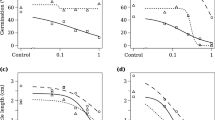Abstract
The effects of toxic components isolated from asparagus tissue onFusarium spp. and other soil microorganisms and their effects on the susceptibility of asparagus toFusarium crown rot was investigated to determine what role allelopathic substances may play in the asparagus ecosystem and in asparagus crown rot decline. Dried sterilized asparagus crown and root tissues were incorporated into pots of 3-month-old asparagus seedlings with and withoutFusarium inoculum. Root tissue alone and treatments in which crown and root tissues were combined with theFusarium inoculum showed significant reduction of plant growth over nontreated controls. Root and crown tissues were partitioned with polar and nonpolar solvents and bioassayed on pregerminated asparagus and cress seeds. Inhibition of radicle growth was confined to the polar fractions. Further separation with paper chromatography gave several fractions that were inhibitory to radish, cress, tomato seed germination as well as inhibitory to growth of pregerminated asparagus seeds. Crude extracts from roots and crown residues were bioassayed on many different fungal isolates on Petri plates and were found to inhibit the growth of oomycetous fungi. Extracts from the roots were found to be more active than extracts from other portions of the asparagus plants.
Similar content being viewed by others
References
Chandler, W.A., andDaniela, J.W. 1974. Effect of leachates from peach soil and roots on bacterial canker and growth of peach seedlings.Phytopathology 64:1281–1284.
Cochrane, V.W. 1948. The role of plant residues in the etiology of root rot.Phytopathology 38:185–196.
Endo, R.M., andBurkholder, E.C. 1971. The association ofFusarium moniliforme with the crown rot complex of asparagus.Phytopathology 61:891 (abstract).
Grogan, R.G., andKimble, K.A. 1959. The association of Fusarium wilt with the asparagus decline and replant problem in California.Phytopathology 49:122–125.
Johnson, S.A., Springer, J.K., andLewis, G.D. 1979.Fusarium moniliforme as a cause of stem and crown rot of asparagus and its association with asparagus decline.Phytopathology 69:778–780.
Kitahara, Y., Yanagawa, M., Kato, T., andTakahashi, N. 1972. Asparagusic acid a new plant growth inhibitor in asparagus.Plant Cell Physiol. 13:923–925.
Komada, H. 1975. Development of a selective medium for quantitative isolation ofFusarium oxysporum from natural soils.Rev. Plant. Plot Res. 8:114–125.
Kommedahl, T., andOhman, J.H. 1960. The role ofAgropyron repens in the seedling blight epidemiology of alfalfa and cereals.Proc. Minn. Acad. Sci. 28:10–14.
Lacy, M.L. 1979. Effects of chemicals on stand establishment and yields of asparagus.Plant Dis. Rep. 63:612–616.
Laufer, G. A., andGarrison, S.A. 1977. The effect of asparagus tissue on seed germination and asparagus seedling growth: Possible allelopathic interactions.Hortic. Sci. 12 (abstract).
Molot, P., andSimone, J. 1965. Study of two factors which aid contamination of asparagus.C.R. Hebd. Seances. Acad. Agric. Fr. 51(5):314–317.
Patrick, Z.A., Toussoun, T.A., andKoch, L.W. 1964. Effect of crop residue decomposition products on plant roots.Annu. Rev. Phytopathol. 2:267–292.
Putnam, A.R.,Hassett, K.Fobes, J.F., andHodupp, R.M. 1982. Evidence for allelopathy and autotoxicity inAsparagus offlcinalis L.Plant Sci. Lett. In press.
Rice, E.L. 1974. Allelopathy. Academic Press, New York, 353 pp.
Rohde, R.A., andJenkins, W.R. 1958. Basis for resistance ofAsparaus officinalis va.altius L. to the stubbing root nematodeTrichodorus christici. Allen 1957.Agric. Exp. Stn. Bull. A-97. University of Maryland, College Park, Maryland.
Rouser, G., andFleischer, S. 1967. Isolation characterization and determination of polar lipids of mitochondria,in R.W. Estabrook and M.E. Pullman (eds.). Methods in Enzymology, Vol. X. Academic Press, New York.
Shafer, W.E., andGarrison, S.A. 1980a. Effects of asparagus root extracts on lettuce and asparagus: Seed germination and growth.Hortic. Sci. 15:242 pp. (abstract).
Shafer, W.E., andGarrison, S.A. 1980b. Effects of decomposing asparagus root tissues on lettuce, tomato, and asparagus seed emergence.Hortic. Sci. 15:240 pp. (abstract).
Toussoun, T.A., andPatrick, Z.A. 1963. Effect of phytotoxic substances from decomposing plant residues on root rot of bean.Phytopathology 53:265–270.
Tuite, J. 1969. Plant Pathological Methods. Burgess Publishing, Minneapolis, Minnesota.
Vanbakel, J.M.M., andKerstens, J.J.A. 1970. Footrot in asparagus caused byFusarium oxysporum f. sp.asparagi.Neth. J. Plant Pathol. 76:320–325.
Author information
Authors and Affiliations
Rights and permissions
About this article
Cite this article
Hartung, A.C., Stephens, C.T. Effects of allelopathic substances produced by asparagus on incidence and severity of asparagus decline due toFusarium crown rot. J Chem Ecol 9, 1163–1174 (1983). https://doi.org/10.1007/BF00982219
Received:
Revised:
Issue Date:
DOI: https://doi.org/10.1007/BF00982219




